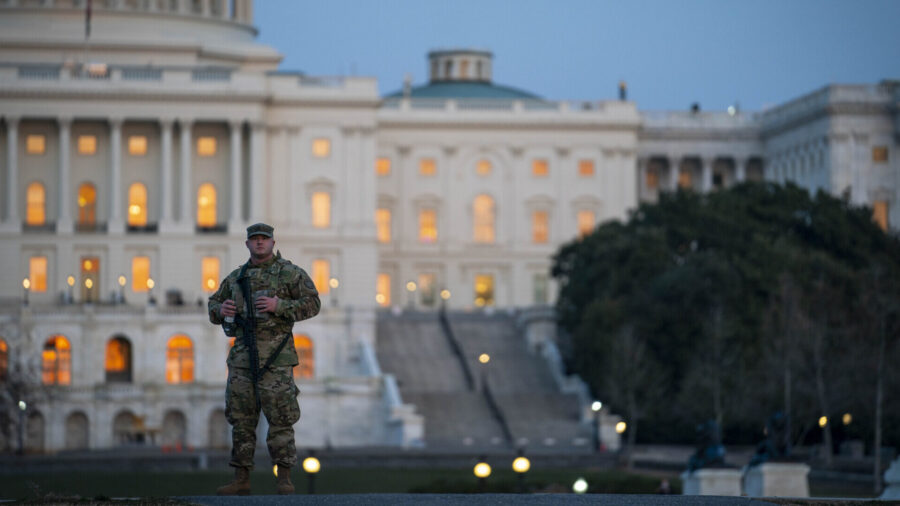The intelligence community has assessed that violent extremists in the country are posing a “heightened threat” in 2021, according to a new unclassified threat assessment.
The brief unclassified summary—assembled by the Office of the Director of National Intelligence (ODNI), the Department of Justice (DOJ), and the Department of Homeland Security (DHS)—found that domestic extremists motivated by a range of ideologies are seen as risks for violence.
It found that extremists motivated by biases against minority populations and perceived government overreach “will almost certainly” drive more “radicalization and mobilization to violence.” Meanwhile, sociopolitical developments such as the narrative of fraud in the 2020 presidential election and the Jan. 6 breach of the U.S. Capitol “will almost certainly spur some [domestic violent extremists] to try to engage in violence this year.”
The assessment was conducted after President Joe Biden in January tasked the DNI to assess the threat of domestic violent extremism following the Jan. 6 breach of the U.S. Capitol. Biden and Democrats elevated the issue following the violence on that day, leaving critics concerned that the new administration may limit their focus on assessing domestic terrorism threats to the Jan. 6 events without attention to the violence unfolding across the country over the summer, triggered by the death of George Floyd.
White House Press Secretary Jen Psaki at the time described the review as a “fact-based analysis” that could be used to shape policy.
Extremism motivated by different world views and political ideologies has posed an ongoing threat to the United States and has prompted multiple FBI investigations into individuals in recent months.
The riots last summer, perpetrated by anarchist extremists, who caused significant economic, property, and human destruction, had brought the issue of domestic extremism back into the public consciousness.
Former Attorney General William Barr over the summer had characterized actions by Antifa and similar groups as “domestic terrorism.” However, Biden’s Attorney General Merrick Garland has stopped short of applying the same label to those violent actors, instead focusing on prosecuting the hundreds of people involved in the Capitol breach on Jan. 6.
U.S. officials in recent weeks have issued warnings about threats of domestic violent extremism, including FBI Director Christopher Wray who testified this month that “domestic terrorism has been metastasizing,” in particular militia violent extremism as well as racially motivated violent extremism. The DHS has also announced almost $2 billion in state and local preparedness grants, with at least $77 million allocated to directly combat domestic violent extremism.
The summary provided a similar assessment on racially or ethnically motivated violent extremists and militia violent extremists (MVE), stating that they present the most lethal threats. It found that some racially motivated extremists are “most likely” to “conduct mass-casualty attacks against civilians,” while militia-related would “typically targeting law enforcement and government personnel and facilities.”
“The IC assesses that the MVE threat increased last year and that it will almost certainly continue to be elevated throughout 2021 because of contentious sociopolitical factors that motivate MVEs to commit violence,” the intelligence officials wrote (pdf).
Among racially motivated extremists, white supremacists are the most likely to have international connections with individuals with similar ideological beliefs. The summary states that these extremists “frequently communicate with and seek to influence each other.” However, the summary noted that only “a small number” of such extremists have traveled abroad to network with like-minded individuals.
The assessment also found that lone offenders or small cells of domestic extremists from different ideologies are “more likely to carry out violent attacks in the Homeland than organizations that allegedly advocate a DVE ideology.” This finding echoes Wray’s assessment from last September, where he told lawmakers during a hearing in the House Homeland Security Committee that individuals who self-radicalize online and carry out attacks pose the most serious threat to the homeland.
“We assess that the greatest threat to the homeland, to us here domestically, is not one organization, certainly not one ideology, but rather lone actors largely self-radicalized online who pursue soft targets using readily accessible weapons,” Wray said last year.
Many of these domestic extremists use social media platforms or small websites with a targeted audience to recruit members, plan and rally for support for in-person actions, and disseminate information that contributes to the radicalization of individuals, the summary found.
The intelligence community also assessed that “escalating support from persons in the United States or abroad, growing perceptions of government overreach related to legal or policy changes and disruptions, and high-profile attacks spurring follow-on attacks and innovations in targeting and attack tactics” could increase the likelihood or lethality of domestic violent attacks in America.
According to the summary, domestic violent extremists are defined as U.S.-based individuals who “conduct or threaten activities that are dangerous to human life in violation of the criminal laws of the United States or any state; appearing to be intended to intimidate or coerce a civilian population; and influence the policy of a government by intimidation or coercion, or affect the conduct of a government by mass destruction, assassination, or kidnapping, as per the definition of domestic terrorism” under federal law.
The assessment did not take into account people who engage in “advocacy of political or social positions, political activism, use of strong rhetoric, or generalized philosophic embrace of violent tactics,” as those actions may be constitutionally protected.
The summary identified a number of domestic violent extremist groups including: racially or ethnically motivated violent extremists, anti-government/anti-authority violent extremists, animal rights environmental violent extremists, and more.
From The Epoch Times


